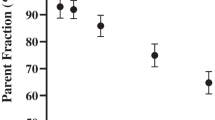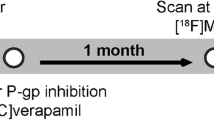Abstract
Objective
One mechanism that may be responsible for drug resistance in epilepsy is the upregulation of P-glycoprotein (P-gp), a drug efflux pump, at the epileptogenic focus. In this study, we sought to evaluate the potential of a recently developed P-gp PET radiotracer, [11C]N-desmethyl-loperamide ([11C]dLop), for measuring P-gp function in the rat brain.
Methods
The precursor to [11C]dLop was synthesized in two steps from commercially available starting materials and subsequently radiolabeled in one step using [11C]methyl iodide. [11C]dLop was then administered to two groups of rats, controls (n = 4) and those treated with a P-gp inhibitor (n = 8). Cyclosporin A (CsA, 50 mg/kg, n = 3) and tariquidar (TQ, 20 mg/kg, n = 5) were both used as P-gp inhibitors. MicroPET brain scans were performed for 120 min with arterial blood sampling. A one-tissue compartment model was used to estimate the distribution volume of radiotracer as the outcome measure of P-gp function.
Results
Plasma levels of parent [11C]dLop decreased rapidly to <0.1 mean standardized uptake value (SUV) at 60 min. In controls, brain uptake of [11C]dLop was very low (<0.1 mean SUV). In contrast, the mean SUVs were significantly higher in rats treated with CsA (0.51) or TQ (0.22). Estimation of distribution volumes was stable by 70 min. Estimated distribution volumes were significantly larger after P-gp inhibition (CsA = 7.3, TQ = 4.7) compared to controls (no inhibitor = 2.1).
Conclusions
The rat brain demonstrates significantly increased uptake of [11C]dLop after P-gp inhibition. [11C]dLop is a substrate of P-gp, and will serve as a promising radiotracer for studying P-gp function in the future.





Similar content being viewed by others
References
Gottesman MM. Mechanisms of cancer drug resistance. Annu Rev Med. 2002;53:615–27.
Luna-Tortos C, Fedrowitz M, Loscher W. Several major antiepileptic drugs are substrates for human P-glycoprotein. Neuropharmacology. 2008;55:1364–75.
Aronica E, Gorter JA, Ramkema M, Redeker S, Ozbas-Gerceker F, van Vliet EA, et al. Expression and cellular distribution of multidrug resistance-related proteins in the hippocampus of patients with mesial temporal lobe epilepsy. Epilepsia. 2004;45:441–51.
Kubota H, Ishihara H, Langmann T, Schmitz G, Stieger B, Wieser HG, et al. Distribution and functional activity of P-glycoprotein and multidrug resistance-associated proteins in human brain microvascular endothelial cells in hippocampal sclerosis. Epilepsy Res. 2006;68:213–28.
Schmidt D, Loscher W. Drug resistance in epilepsy: putative neurobiologic and clinical mechanisms. Epilepsia. 2005;46:858–77.
Bigott HM, Prior JL, Piwnica-Worms DR, Welch MJ. Imaging multidrug resistance P-glycoprotein transport function using microPET with technetium-94 m-sestamibi. Mol Imaging. 2005;4:30–9.
Piwnica-Worms D, Chiu ML, Budding M, Kronauge JF, Kramer RA, Croop JM. Functional imaging of multidrug-resistant P-glycoprotein with an organotechnetium complex. Cancer Res. 1993;53:977–84.
Hendrikse NH, Franssen EJ, van der Graaf WT, Meijer C, Piers DA, Vaalburg W, et al. 99mTc-sestamibi is a substrate for P-glycoprotein and the multidrug resistance-associated protein. Br J Cancer. 1998;77:353–8.
Tournier N, Cisternino S, Peyronneau MA, Goutal S, Dolle F, Scherrmann JM, et al. Discrepancies in the P-glycoprotein-mediated transport of (18)F-MPPF: a pharmacokinetic study in mice and non-human primates. Pharm Res. 2012;29:2468–76.
Kurdziel KA, Kiesewetter DO, Carson RE, Eckelman WC, Herscovitch P. Biodistribution, radiation dose estimates, and in vivo Pgp modulation studies of 18F-paclitaxel in nonhuman primates. J Nucl Med. 2003;44:1330–9.
Takano A, Kusuhara H, Suhara T, Ieiri I, Morimoto T, Lee YJ, et al. Evaluation of in vivo P-glycoprotein function at the blood-brain barrier among MDR1 gene polymorphisms by using 11C-verapamil. J Nucl Med. 2006;47:1427–33.
Lubberink M, Luurtsema G, van Berckel BN, Boellaard R, Toornvliet R, Windhorst AD, et al. Evaluation of tracer kinetic models for quantification of P-glycoprotein function using (R)-[11C]verapamil and PET. J Cereb Blood Flow Metab. 2007;27:424–33.
Zoghbi SS, Liow JS, Yasuno F, Hong J, Tuan E, Lazarova N, et al. 11C-loperamide and its N-desmethyl radiometabolite are avid substrates for brain permeability-glycoprotein efflux. J Nucl Med. 2008;49:649–56.
Lazarova N, Zoghbi SS, Hong J, Seneca N, Tuan E, Gladding RL, et al. Synthesis and evaluation of [N-methyl-11C]N-desmethyl-loperamide as a new and improved PET radiotracer for imaging P-gp function. J Med Chem. 2008;51:6034–43.
Kannan P, Brimacombe KR, Zoghbi SS, Liow JS, Morse C, Taku AK, et al. N-desmethyl-loperamide is selective for P-glycoprotein among three ATP-binding cassette transporters at the blood-brain barrier. Drug Metab Dispos. 2010;38:917–22.
Kannan P, Brimacombe KR, Kreisl WC, Liow JS, Zoghbi SS, Telu S, et al. Lysosomal trapping of a radiolabeled substrate of P-glycoprotein as a mechanism for signal amplification in PET. PNAS. 2011;108:2593–8.
Liow JS, Kreisl W, Zoghbi SS, Lazarova N, Seneca N, Gladding RL, et al. P-glycoprotein function at the blood-brain barrier imaged using 11C-N-desmethyl-loperamide in monkeys. J Nucl Med. 2009;50:108–15.
Kreisl WC, Liow JS, Kimura N, Seneca N, Zoghbi SS, Morse CL, et al. P-glycoprotein function at the blood-brain barrier in humans can be quantified with the substrate radiotracer 11C-N-desmethyl-loperamide. J Nucl Med. 2010;51:559–66.
Seneca N, Zoghbi SS, Liow JS, Kreisl W, Herscovitch P, Jenko K, et al. Human brain imaging and radiation dosimetry of 11C-N-desmethyl-loperamide, a PET radiotracer to measure the function of P-glycoprotein. J Nucl Med. 2009;50:807–13.
Moerman L, Wyffels L, Slaets D, Raedt R, Boon P, De Vos F. Antiepileptic drugs modulate P-glycoproteins in the brain: a mice study with (11)C-desmethyl loperamide. Epilepsy Res. 2011;94:18–25.
Bankstahl JP, Bankstahl M, Kuntner C, Stanek J, Wanek T, Meier M, et al. A novel positron emission tomography imaging protocol identifies seizure-induced regional overactivity of P-glycoprotein at the blood-brain barrier. J Neurosci. 2011;31:8803–11.
la Fougere C, Boning G, Bartmann H, Wangler B, Nowak S, Just T, et al. Uptake and binding of the serotonin 5-HT1A antagonist [18F]-MPPF in brain of rats: effects of the novel P-glycoprotein inhibitor tariquidar. NeuroImage. 2010;49:1406–15.
Bankstahl JP, Kuntner C, Abrahim A, Karch R, Stanek J, Wanek T, et al. Tariquidar-induced P-glycoprotein inhibition at the rat blood–brain barrier studied with (R)-11C-verapamil and PET. J Nucl Med. 2008;49:1328–35.
Bart J, Willemsen AT, Groen HJ, van der Graaf WT, Wegman TD, Vaalburg W, et al. Quantitative assessment of P-glycoprotein function in the rat blood-brain barrier by distribution volume of [11C]verapamil measured with PET. NeuroImage. 2003;20:1775–82.
Kuntner C, Bankstahl JP, Bankstahl M, Stanek J, Wanek T, Stundner G, et al. Dose-response assessment of tariquidar and elacridar and regional quantification of P-glycoprotein inhibition at the rat blood-brain barrier using (R)-[(11)C]verapamil PET. Eur J Nucl Med Mol Imag. 2010;37:942–53.
Syvanen S, Luurtsema G, Molthoff CF, Windhorst AD, Huisman MC, Lammertsma AA, et al. (R)-[11C]verapamil PET studies to assess changes in P-glycoprotein expression and functionality in rat blood-brain barrier after exposure to kainate-induced status epilepticus. BMC Med Imaging. 2011;11:1.
van Waarde A, Ramakrishnan NK, Rybczynska AA, Elsinga PH, Berardi F, de Jong JR, et al. Synthesis and preclinical evaluation of novel PET probes for P-glycoprotein function and expression. J Med Chem. 2009;52:4524–32.
Muzi M, Mankoff DA, Link JM, Shoner S, Collier AC, Sasongko L, et al. Imaging of cyclosporine inhibition of P-glycoprotein activity using 11C-verapamil in the brain: studies of healthy humans. J Nucl Med. 2009;50:1267–75.
Lee HB, Blaufox MD. Blood volume in the rat. J Nucl Med. 1985;26:72–6.
Hendrikse NH, Schinkel AH, de Vries EG, Fluks E, Van der Graaf WT, Willemsen AT, et al. Complete in vivo reversal of P-glycoprotein pump function in the blood-brain barrier visualized with positron emission tomography. Br J Pharmacol. 1998;124:1413–8.
Acknowledgments
We thank the Columbia University PET center staff for their technical assistance. We also thank Paul E. Harris, PhD for his technical assistance. The authors have no conflicts of interest to declare.
Author information
Authors and Affiliations
Corresponding author
Rights and permissions
About this article
Cite this article
Farwell, M.D., Chong, D.J., Iida, Y. et al. Imaging P-glycoprotein function in rats using [11C]-N-desmethyl-loperamide. Ann Nucl Med 27, 618–624 (2013). https://doi.org/10.1007/s12149-013-0725-5
Received:
Accepted:
Published:
Issue Date:
DOI: https://doi.org/10.1007/s12149-013-0725-5




